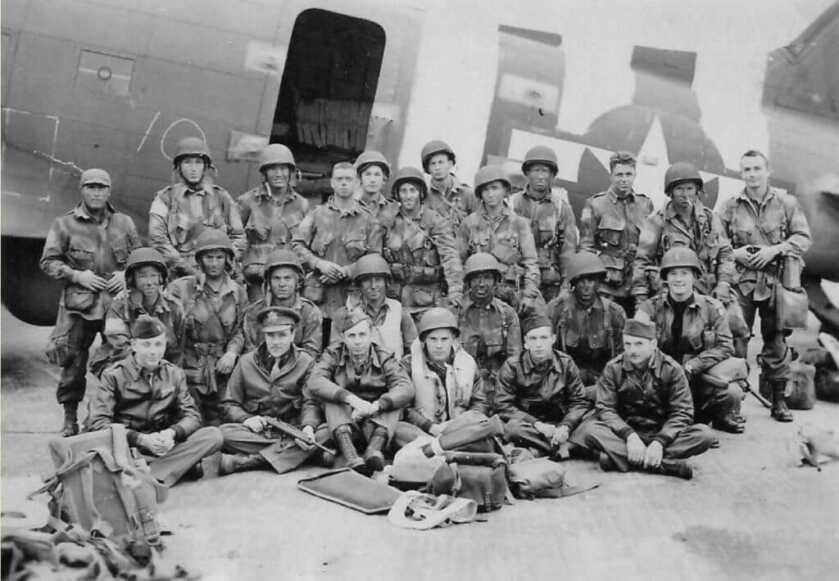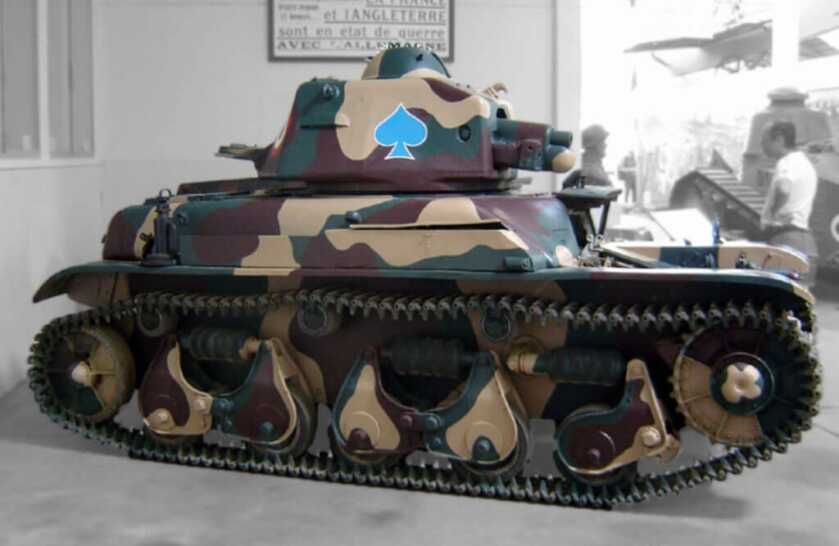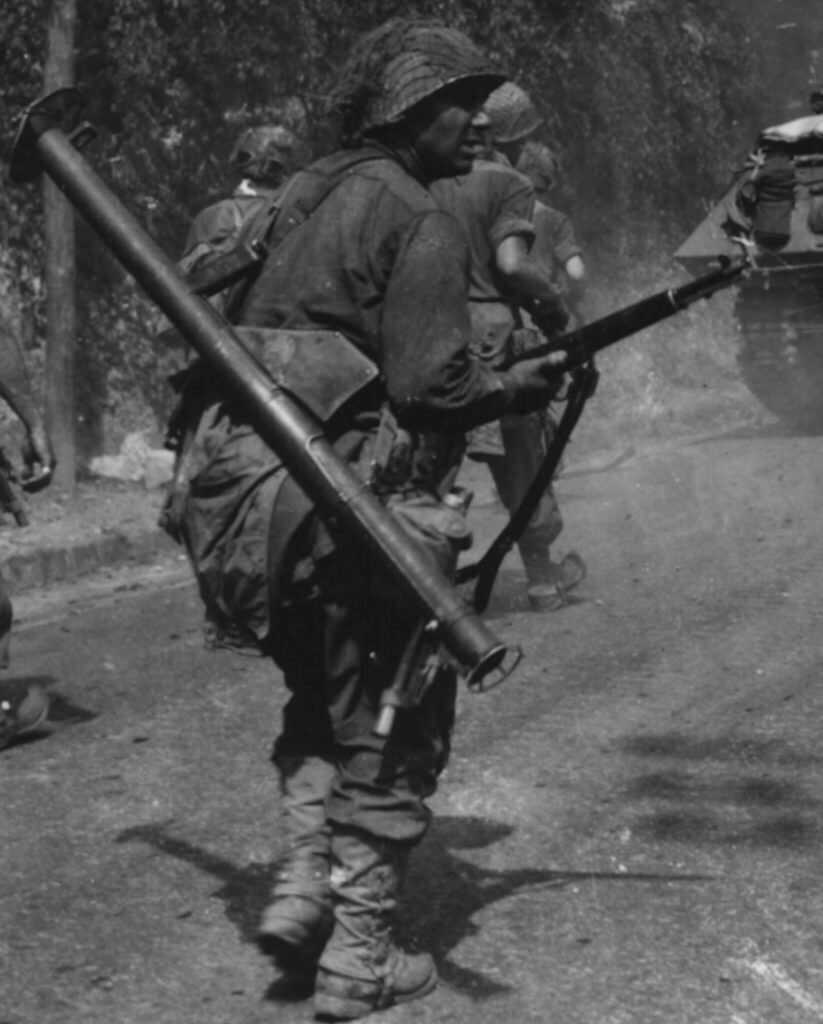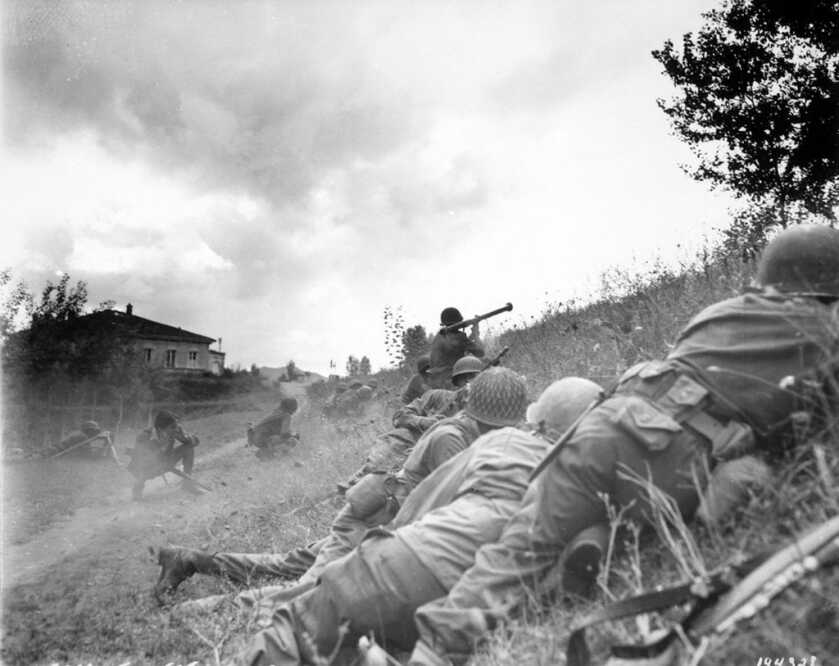
Estimated reading time: 11 minutes
The bridge is small and unassuming. In my part of the Deep South, it might be suitable to cross a small creek or generous drainage ditch. It is formed from meticulously cut stone. It’s the sort of bridge that, if left to its own devices, might last about forever. However, on the 6th and 7th of June, 1944, this modest little bridge was the focus of some of the worst fighting of World War 2. Historians have described the battle for this otherwise unremarkable place as, “Probably the bloodiest small unit struggle in the experience of American arms.”
Just like the real estate business, the relative value of a military objective is driven by its location. In military terms, this modest little bridge was prime beachfront condominium property. The La Fière Bridge represented a choke point on the major causeway leading off of Utah Beach. If US airborne forces couldn’t seize and hold this bridge, the assault troops couldn’t push inland. If the invasion did not secure a generous lodgment in the first few days then the Germans might be able to mobilize their armored reserves and push the Allied armies into the sea. The handful of paratroopers and glidermen who found themselves at the La Fière Bridge on D-Day knew all of this. If they failed the invasion could fail. That unenviable gravitas weighed heavily on them all.
Citizen Soldiers
Robert Murphy’s father fought in World War 1. He helped young Bob alter his birth certificate when he was 17 so he could enlist in the US Army. That was in October of 1942. By D-Day, Bob Murphy was a trained Pathfinder assigned to the 505th Parachute Infantry Regiment. On D+1, Murphy was serving as a runner. Radio communications between infantry units back then were unreliable on a good day. Amidst the unfettered chaos of the battle for Normandy, the best way to pass a message was via the written word. It was Bob’s job to get those messages to combat commands under fire.

Paratroopers were horribly intermixed as they jumped into the darkness above the Norman countryside on 6 June 1944. Unit integrity was lost almost immediately. Scratch units pulled together troops from various commands under the control of whoever was handy. Sergeant Billy Owen ended up commanding the forward elements in this case. Owen sent a message to his commander, LT John “Red Dog” Dolan, via Bob Murphy explaining that he was running out of healthy bodies and was perilously low on ammunition. Dolan sent Murphy back a handwritten note that read, “I know of no better spot to die. We stay.” And stay they did.
The Bridge Setting

The bridge sits roughly a mile west of St. Mere-Eglise over the Merderet River. The Germans held the terrain west of the river, but it was marshy and soft. The Germans had a few tanks, but this was lousy tank country. The German high command had intentionally flooded this area prior to the invasion to dissuade paratroopers. While quite a few American airborne troopers drowned during the initial drop, all that water now served to canalize the counterattacking German tanks onto the causeway approaching the bridge.
The Americans had disabled a truck on the approach to the bridge and had also planted a handful of antitank mines as part of their ad hoc defense. The road approaching the bridge curved sharply some 60 meters distant. This fortuitous bit of geography kept the attacking German tanks from taking advantage of their superior range. This was to be a pitiless close fight. A lot of men would die before the bridge issue was decided.
The Tank
Every Allied soldier who encountered a German tank seems to have reported it as either a Panther or Tiger. However, the reality was that the Wehrmacht and SS used a wide variety of tank types. This failure to standardize on a single simple design suitable for mass production helped them lose the war. On this most critical afternoon, the German tankers approaching the La Fière Bridge were manning a weird amalgam of repurposed armor.

The Germans launched two major armored assaults against the bridge. Armored forces were drawn from the Panzer Ersatz und Ausbildungs Abteilung 100 (100th Panzer Replacement Battalion). This ad hoc unit was equipped with fourteen French Renault R35 tanks seized during the Blitzkrieg assault across the continent several years before. These small tanks were committed in support of the 1057th Panzer Grenadier Regiment tasked to dislodge the 505th PIR.

The Attacks on the Bridge
The first attack consisted of two R35s and a single Hotchkiss H39 amply supported with infantry. Both the R35 and the H39 were badly outclassed by this point in the war. Their armor plate was a mere 43mm thick at its maximum point and was therefore proof against small arms and little else. Each tank carried a 37mm main gun as well as a 7.5mm French machinegun. These vehicles had previously been used for driver training and general security. If facing American Shermans or British Churchills, the R35 and H39 would have been easy meat. However, arrayed against lightly-armed paratroopers, these small two-man armored vehicles were nonetheless terrifying.

Arrayed against the attacking Germans, the Americans could count on a single 57mm antitank gun and three 2-man bazooka teams. LT Dolan sited the AT gun back some 150 yards from the bridge to give its crew an optimal field of fire. He held one Bazooka team in reserve and deployed the other two across the bridge. Each bazooka team consisted of a gunner and a loader. As these were paratroopers at the end of their first full day in combat they were running low on everything, especially bazooka rockets. This was going to be an epic scrap.

The two lead R35s attacked at around 1700 on 6 June. They were separated by about 15 yards with the H39 another 50 yards behind. The Germans were raining machinegun and mortar fire all over the defending Americans. LT Dolan posted one Bazooka team on each side of the road leading up to the bridge. They opened fire at a range of 40 yards.

An American machine gunner killed the German tank commander in the lead tank with a burst of automatic weapons fire. Like most good German tank commanders, he was guiding his vehicle with his head outside the hatch. This was what ultimately killed him. As the commander in the R35 was also the gunner and loader, this effectively defanged the little French tank. American paratroopers Lenold Peterson and Marcus Helm nonetheless slammed 2.36-inch rockets into the lead tank as fast as they could cycle the weapon. Troopers Bolderson and Pryne did the same thing from the other side of the road.

With the lead tank now disabled, the second armored vehicle pressed forward to push it out of the way. Helm and Peterson then shifted their attention to that tank, Bolderson and Pryne having been neutralized by heavy German fire. Peterson landed a rocket on the turret ring and another against the vehicle’s tracks. Now out of rockets and with the second tank on fire, Trooper Helm braved German fire to run across the road and retrieve the extra rockets abandoned by the other team, both of whose members were now wounded. Once back with Peterson, the two men began pumping rockets into the third tank.
According to LT Dolan, the four bazooka men loaded and fired their weapons as though they were on the training range despite the withering German fire. The 57mm AT gun ultimately found the range and knocked out the third tank for good. A Major Kellam and CPT Roysden attempted to run a bag of rockets up to these forward positions only to be cut down by mortar fire. In the process, both forward-deployed bazookas were destroyed.

The following day the Germans tried again, this time with what was likely a pair of German Panzerkampfwagen Mk III’s. The Americans now had a single operational bazooka. Additionally, the AT gun crew had fled, taking the firing mechanism for the gun with them. LT Dolan organized a desperate defense with Gammon grenades. The Gammon bomb was a British contrivance that consisted of little more than a cloth sack filled with explosives and equipped with a contact fuse. If you were lobbing Gammon grenades at German tanks your day was seriously sucking.
Just when things seemed most dire, a pair of young AT gunners returned with the firing mechanism for the gun and engaged the two German tanks, setting them both alight. Both of these young men earned the Silver Star, and the airborne company held until relieved.
The Weapon
What ultimately became the M1 2.36-inch bazooka began as a side project birthed by the famous rocket scientist Robert Goddard. The concept combined the warhead from the hand-thrown M10 antitank grenade with a rocket motor to substantially increase the weapon’s effective range. LT Edward Uhl was tasked to work out the details. He later explained, “I was walking by this scrap pile, and there was a tube that… happened to be the same size as the grenade that we were turning into a rocket. I said, That’s the answer! Put the tube on a soldier’s shoulder with the rocket inside, and away it goes.”

READ MORE: LTC Charles “Bazooka Charlie” Carpenter: Rosie the Rocketer
Early launchers used dry cell batteries for ignition, but these were found to be unreliable. The definitive M9 two-piece takedown launcher employed a manual magneto sparker system to ignite the M6A3 blunt-nosed rocket. This improved round offered better detonation at sharp angles of impact than did the previous pointed rocket and would cut through 3.5-4 inches of steel armor. The M9 weighed 14.3 pounds and was 61 inches long.
The Rest of the Story

The bitter fight for the La Fière Bridge cost some 250 American lives, but they held the bridge. The combat power that flowed across that little bridge did not stop until Hitler killed himself and the Germans capitulated. The details of the engagement bear a striking similarity to the final scene in the epic Stephen Spielberg movie Saving Private Ryan. In this case, however, truth is even more compelling than fiction.
*** Buy and Sell on GunsAmerica! ***


dr. dabbs, thank you for your writing, i don’t get a lot of history anymore. my father was in the navy in wwii but never said a word about anything. these people are all heroes to me.
Another excellent article, and inspiring tribute to the ones who sacrificed all. Thank you, Will.
Visited the bridge area as part of a Normandy staff ride in 2000. I was unaware of the German’s attempt to take tanks across the bridge and causeway. It was mentioned the paratroopers did try to cross the causeway without success and took heavy losses.
It’s definitely a good example of how even an otherwise ‘inferior’ weapon like those R35 and H39 tanks can still be deadly if you’re not well equipped to fight them. There were so many of these small engagements where brave men made the ultimate sacrifice that simply get overlooked because they haven’t been featured in popular media. Thanks for this enlightening bit of history, I always look forward to your columns.
I was assigned to Dolan Barracks, Hessental, West Germany in the 1980’s. A former WWII German airbase, it was home to 223rd Aviation Bn, 3/58 Air Traffic Control and 12th Aviation Group. Sadly, it was closed down shortly after the Persian Gulf war.
Thanks for the refresher on how it earned it’s name.
SGT Ricci, 505th PIR, 82nd Airborne, though wounded, survived the Battle, and returned to SW Illinois after VE Day to complete studies at St. Louis College of Pharmacy. He was married with children when drafted and volunteered Airborne for the Jump Pay to better support his family. SGT Ricci’s son, James, served our communities as an Internist for a full career and was my Primary Care Physician until retiring in 2021. Dr. Ricci told me about his father’s heroics and encouraged me to read the book, No Better Place to Die by Robert Murphy. Father and Son both very good men!
Great story of the Normandy Invasion. Little battles, but quite large for the men involved, are always a great story, because it describes most of the battle rather than knowable vignettes. Recently I was at a conference that was held in Monroe, Michigan, and heard the great story of this battle that took place there in January of 1813 on the River Raisin. The 2nd Battle of Frenchtown cost more American casualties than any other in the War of 1812.
WHEN do you think “Hollywood”…(Spielberg & Tom Hamks) are going to make a movie about La Fiere Bridge like what was done with “BAND OF BROTHERS” & “THE PACIFIC”…..????………..Dale Dye started gathering pre-production info & equipment/Script but never finished the project…….probably due to lack of funding…………THIS is an important story and should be told.
Dr. Dabbs histories are great. I look for them in every e-mail from GunsAmerica. Keep up the great work.